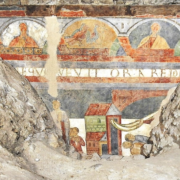Posts
https://www.artwatchinternational.com/wp-content/uploads/2005/02/2005-02-10-Michelangelo-David-head.jpg
808
678
Kenn Richards
https://www.artwatchinternational.com/wp-content/uploads/2017/09/Artwatch-International-300x138.jpg
Kenn Richards2005-02-10 11:58:432017-11-09 11:44:41DAVID MANIA!!!
https://www.artwatchinternational.com/wp-content/uploads/2005/01/2005-01-26-Scrovegni-Chapel-Padua.jpg
402
580
Kenn Richards
https://www.artwatchinternational.com/wp-content/uploads/2017/09/Artwatch-International-300x138.jpg
Kenn Richards2005-01-26 09:27:572017-11-09 11:49:37Removal of Trees at the Scrovegni
https://www.artwatchinternational.com/wp-content/uploads/2017/09/Artwatch-International-300x138.jpg
0
0
Kenn Richards
https://www.artwatchinternational.com/wp-content/uploads/2017/09/Artwatch-International-300x138.jpg
Kenn Richards2001-10-15 00:00:002017-09-14 14:00:20Radical Treatment of 14th &15th Century Fresco Cycle in the Camposanto, Pisa.
https://www.artwatchinternational.com/wp-content/uploads/2017/09/Artwatch-International-300x138.jpg
0
0
Kenn Richards
https://www.artwatchinternational.com/wp-content/uploads/2017/09/Artwatch-International-300x138.jpg
Kenn Richards2001-10-10 20:14:072017-09-14 13:58:37Giotto and Business as Usual
https://www.artwatchinternational.com/wp-content/uploads/2017/09/Artwatch-International-300x138.jpg
0
0
Kenn Richards
https://www.artwatchinternational.com/wp-content/uploads/2017/09/Artwatch-International-300x138.jpg
Kenn Richards2001-07-01 00:00:002017-09-14 13:38:44Modern Restoration & the Renovated Crucifix in the Duomo of Crema
https://www.artwatchinternational.com/wp-content/uploads/2001/03/2001-03-01-Sant-Orso-Cathedral-painting-Ottonian-Renaissance.png
546
940
Kenn Richards
https://www.artwatchinternational.com/wp-content/uploads/2017/09/Artwatch-International-300x138.jpg
Kenn Richards2001-03-01 00:00:002018-04-05 17:47:08Aosta. Presentazione dei Atti, Medioevo aostano: La Pittura intorno all'anno mille in Cattedrale e in Sant'Orso.
https://www.artwatchinternational.com/wp-content/uploads/2001/02/2001-02-06-Churches-Charge-Admission-Santa-Maria-Novella-admission-tourism-Florence.png
680
1024
Kenn Richards
https://www.artwatchinternational.com/wp-content/uploads/2017/09/Artwatch-International-300x138.jpg
Kenn Richards2001-02-06 00:00:002018-04-05 17:37:53City of Florence to Charge Admission at Santa Maria Novella
https://www.artwatchinternational.com/wp-content/uploads/2000/11/2000-11-02-Masaccio-Trinity-Santa-Maria-Novella.jpg
1024
468
Kenn Richards
https://www.artwatchinternational.com/wp-content/uploads/2017/09/Artwatch-International-300x138.jpg
Kenn Richards2000-11-02 00:00:002017-12-12 16:51:00Masaccio's Trinity: The Tyranny of the Fragment
https://www.artwatchinternational.com/wp-content/uploads/2000/03/2000-03-01-Raphael-Madonna-of-the-Chair-with-St.-John-the-Baptiste-as-Child.jpg
820
695
Kenn Richards
https://www.artwatchinternational.com/wp-content/uploads/2017/09/Artwatch-International-300x138.jpg
Kenn Richards2000-03-01 00:00:002017-12-12 16:44:54On Traveling Exhibitions
https://www.artwatchinternational.com/wp-content/uploads/1998/06/1998-06-22-Michelangelo-Victory.jpg
835
818
Kenn Richards
https://www.artwatchinternational.com/wp-content/uploads/2017/09/Artwatch-International-300x138.jpg
Kenn Richards1998-06-22 00:00:002017-12-12 16:31:56Letter to the Mayor of Florence: Michelangelo's "Victory"
Scroll to top




 The Institute, in collaboration with various research bodies (CNR laboratories, Fisbat in Bologna, CNR Institute of Chemistry and Technology of Radio-elements in Padua, CNR Centre for the study of art works in Rome, the Institute of General Chemistry at Venice University) therefore carried out a number of surveys between 1977 and 1979, aimed at discovering the causes and the mechanism behind the deterioration, in the light of research into the overall conservation history.
The Institute, in collaboration with various research bodies (CNR laboratories, Fisbat in Bologna, CNR Institute of Chemistry and Technology of Radio-elements in Padua, CNR Centre for the study of art works in Rome, the Institute of General Chemistry at Venice University) therefore carried out a number of surveys between 1977 and 1979, aimed at discovering the causes and the mechanism behind the deterioration, in the light of research into the overall conservation history.



 L’esito finale di una iniziativa messa in opera più di una decina di anni fà, quando allora c’era il signor Rollandin, Presidente della Regione, René Faval, Assessore alla Cultura, il Dr. Domenico Prola e Flaminia Montanari alla Soprintendenza delle Belle Arti, si é concrettizzata oggi con questi volumi che contenono gli atti del Convegno.
L’esito finale di una iniziativa messa in opera più di una decina di anni fà, quando allora c’era il signor Rollandin, Presidente della Regione, René Faval, Assessore alla Cultura, il Dr. Domenico Prola e Flaminia Montanari alla Soprintendenza delle Belle Arti, si é concrettizzata oggi con questi volumi che contenono gli atti del Convegno.






 In an open letter to the Mayor of Florence, ArtWatch is calling for an immediate halt to the restoration of Michelangelo’s statue group known as “Victory”.
In an open letter to the Mayor of Florence, ArtWatch is calling for an immediate halt to the restoration of Michelangelo’s statue group known as “Victory”.